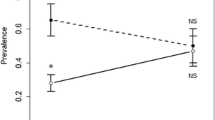Abstract
3782 small wild mammals trapped during a 4 year survey have been examined in relation to a possible contamination by dermatophytes. 15.78% of the animals were contaminated.
The prevailing species wereMicrosporum persicolor andTrichophyton mentagrophytes. The bank voles were significantly more contaminated byM. persicolor (11.63%) than byT. mentagrophytes (4.36%). On the contrary the wood mice were more contaminated byT. mentagrophytes: 13.95% as against 3.50% contaminated byM. persicolor. The male bank voles (13.33%) were more contaminated than the females (9.45%) byM. persicolor and the male wood mice (17.09%) more contaminated than the females (9.95%) byT. mentagrophytes. The occurrence ofM. persicolor in common hamster is noted for the first time. The existence of a pathological lesion in relation to the fungal contamination was noted in the small group of rodents examined histologically: WhenT. mentagrophytes was isolated the hairs were invaded in the endo-ectothrix type pattern; whenM. persicolor was cultivated, hairs are not attacked but only the epidermis.
Résumé
Des 3782 petits mammifères sauvages capturés au cours d'une enquête poursuivie pendant plus de 4 ans, 15,78% sont contaminés par des dermatophytes.
Les espèces de dermatophytes ou champignons, apparentés qui sont rencontrées ne sont que 6;Microsporum persicolor etTrichophyton mentagrophytes sont les espèces dominantes. Les campagnols roussâtres sont, de façon significative, plus contaminés parM. persicolor (11,63%) que parT. mentagrophytes (4,36%). Au contraire, les mulots sont plus contaminés parT. mentagrophytes: 13,95% contre 3,50% contaminés parM. persicolor. Les campagnols roussâtres mâles (13,33%) sont plus contaminés que les femelles (9,45%) parM. persicolor et les mulots mâles (17,09%) plus contaminés que les femelles (9,95%) parT. mentagrophytes. La présence deM. persicolor est notée pour la première fois chez le grand hamster. L'étude histologique de certains animaux permet de remarquer l'existence de lésions dermatophytiques. A l'isolement deT. mentagrophytes correspond une attaque pilaire de type endo-ectothrix; à l'isolement deM. persicolor correspond une attaque limitée à l'épiderme.
Similar content being viewed by others
Bibliographie
Ajello, L. 1974. Natural history of the dermatophytes and related fungi. Mycopath. Mycol. Appl. 53: 93–110.
Badillet, G., B. Gilot, P. Pietrini & M. E. Espinosa-Villegas. 1972. Microsporum persicolor chez l'homme et chez l'animal. Bull. Soc. Fr. Mycol. Méd., 1: 11–14.
Blank, F. 1955. Dermatophytes of animal origin transmissible to man. Am. J. Med. Sci., 229: 302–316.
Chatelain, Jacqueline. 1975. Etude de l'écologie de l'Apodemus en Alsace et son rôle possible dans le cycle du virus de l'encéphalite à tiques. Thèse Doctorat 3e Cycle, Université Paris VI.
English, Mary P. 1967. Ringworm in wild animals. J. Zool, Lond. 153: 556–561.
English, Mary P. 1967. The nature of Trichophyton persicolor infection in the bank vole and the interpretation of the results of sampling technique. Sabouraudia. 5: 295–301.
English, Mary P. 1969. Ringworm in wild animals: further investigations. J. Zool., Lond. 159: 515–522.
English, Mary P. 1971. Ringworm in groups of wild mammals. J. Zool., Lond. 165: 535–544.
English, Mary P. 1972. The epidemiology of animal ringworm in man. Br. J. Derm. 86 Suppl. 8: 78–87.
English, Mary P. & H. N. Southern. 1967. Trichophyton persicolor infection in a population of small wild mammals. Sabouraudia, 5: 302–309.
Houin, R., Y. Rouget-Campana, Y. Le Fichoux, F. Lancastre, J. C. Bazin, M. Deniau et J. Bolignini. 1972. Isolement de Trichophyton mentagrophytes Nannizia persicolor et Trichophyton terrestre du pelage de rongeurs. Ann. Parasitol. Hum. Comp. 47: 421–429.
Mariat, F., Jacqueline Chatelain et Marie-Ange Rouffaud. 1975. Flore dermatophytique des petits mammifères sauvages en Alsace. Résultats définitifs portant sur près de 4000 animaux. Bull. Soc. Fr. Mycol. Méd.: 4: 211–214.
Mariat, F., C. Hannoun et Jacqueline Chatelain. 1972. Flore dermatophytique des petits mammifères sauvages en Alsace. Note préliminaire. Bull. Soc. Fr. Mycol. Méd. 2: 17–20.
Mariat, F. & Gladys Tapia. 1966. Dénombrement des champignons kératinophiles d'une population de cynocéphales (Papio papio). Ann. Parasitol. Hum. Comp. 41: 627–634.
Padhye, A. A., F. Blank, P. J. Koblenzer, S. Spatz & L. Ajello. 1973. Microsporum persicolor infection in the United States. Arch. Dermat. 108: 561–562.
Padhye, A. A., & L. Ajello. 1974. Further observations on Nannizzia persicolor (= ‘N. quinckeani”). Sabouraudia. 12: 362–363.
Ramos, C. D., & A. T. Londero. 1975. Dermatofitose por Microsporum persicolor primeiro caso brasileiro. Rev. Inst. Med. Trop., Sao Paulo, 17: 126–128.
Author information
Authors and Affiliations
Rights and permissions
About this article
Cite this article
Mariat, F., Chatelain, J. & Rouffaud, M.A. Etude sur la contamination par les champignons dermatophytes d'une population de petits mammiferes sauvages en Alsace. Mycopathologia 58, 71–78 (1976). https://doi.org/10.1007/BF00707175
Issue Date:
DOI: https://doi.org/10.1007/BF00707175




